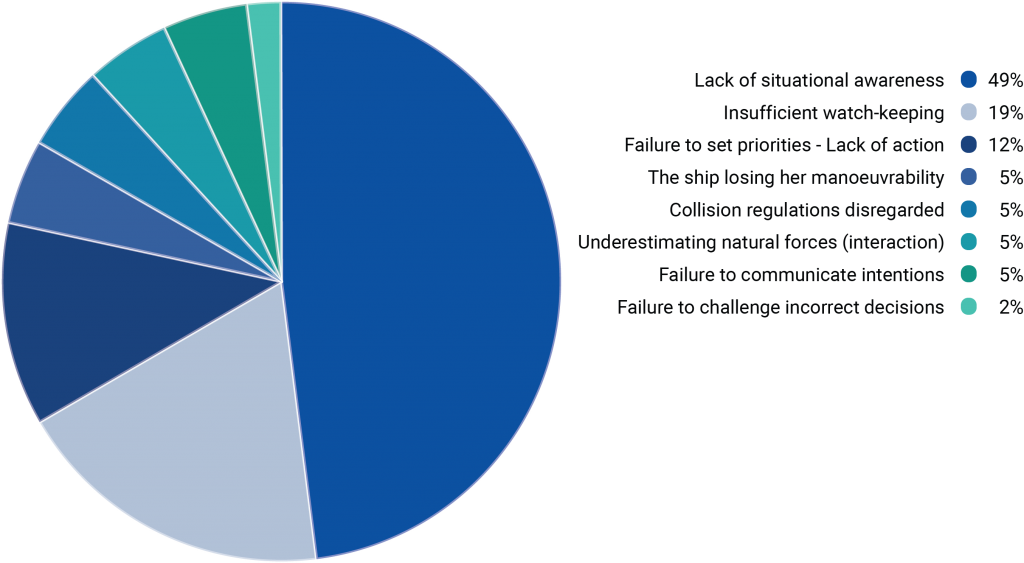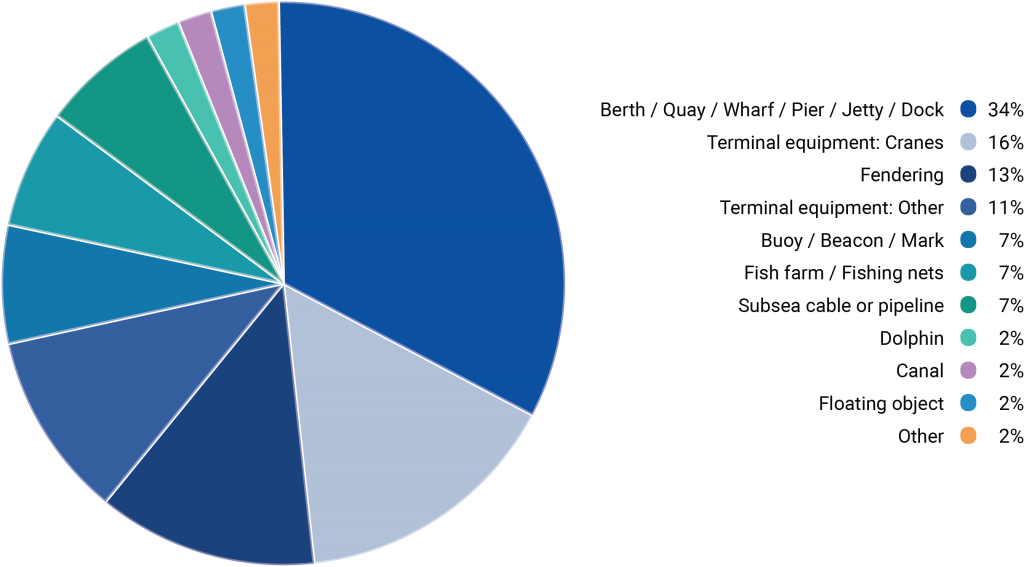Section 2 Collision with other ships
7.2.1 Adaption of P&I to Hull cover for liability risks
Whilst the main function of the Hull insurance is compensation for loss of or damage to the insured ship – in that sense the Hull insurance is a property insurance – important elements of insurance against liability and salvage risks have been added. The extent of liability cover under the Hull insurance is defined in the applicable Hull conditions, for the remaining liability risks cover may be sought under the P&I Insurance.
The collision liability left to be covered under the P&I policy depends on the exclusions under the Hull cover. Whilst some exclusions are covered under other Rules such as Rule 3 (Liabilities in respect of persons) and Rule 6 (Liabilities in respect of pollution), this section of Rule 7 provides protection against some other important exclusions under the Hull insurance viz. limitation in a Hull cover to the collision liability as well as liability in excess of the Hull insurance value. It also covers any part of collision compensation payable under U.S. law which refers to cargo carried on board the entered ship.
7.2.2 1/4 RDC (Running Down Clause)
7.2.2.1 General comments on 1/4 RDC
Traditionally, Hull insurance covers only 3/4 of the collision liability, the “uninsured deductible” of the remaining 1/4 collision liability rests with the P&I Clubs; the 1/4 RDC (Running Down Clause) is, accordingly, one of the traditional P&I risks. Nowadays, Hull insurance often covers 4/4 of the collision liability.

No of claims 2015-2019
7.2.2.2 When 4/4 RDC covered under hull policy
When Hull insurance provides cover for full collision liability or 4/4 RDC, no cover for 1/4 RDC is required under the P&I policy.
7.2.2.3 Cover of 1/4 RDC makes P&I the leading underwriter in collision cases
Should 1/4 RDC cover rest with the P&I Club, traditionally P&I takes the claims lead, including negotiation and settlement, on behalf of all the underwriters concerned. This is because the hull cover is usually split between various insurers who will cover less than 25% individually.
7.2.3 Collision liability apportionment – single or cross?
7.2.3.1 General comments on collision liability apportionment
The apportionment of collision liability is simple where one of the ships is 100% to blame or where neither of the two ships is at fault. In the first case, the entire liability is paid by the one vessel or its Underwriters (depending who carries the collision liability). In the second case each ship bears its own loss.
In the majority of collision cases, fault is found on the part of both ships leading to a shared blame based on the degree of fault. The division of liability is often reached through an amicable settlement between the parties; should the negotiations fail, the case will need to be decided in court.
There are two ways of apportioning collision liability viz., the single and the cross liability systems.
7.2.3.2 Single liability
In the single liability system the agreed liability apportionment is applied to the aggregate amount of the losses sustained by the two ships. Depending on the quantified losses and the proportion of blame one ship will receive compensation from the other ship, respectively its underwriters. Usually, the losses suffered by one ship consist of both insured and uninsured losses (for example hull damage, loss of time, deductibles etc.). The disadvantage of a single liability settlement is the distribution amongst the various parties often concerned for one ship, which would then often be based on an assumed cross liability settlement.
7.2.3.3 Cross liability
In the cross liability system the liability is apportioned not on the aggregate of the two ship’s losses but on the loss each ship sustained individually. It is then possible to apportion each part of the individual loss, whether it is insured Hull damage, P&I’s proportion to the collision, insured loss of time or an uninsured loss sustained by the shipowner.
Which system is to be preferred or offers more equality depends on various factors, such as stipulations in the Hull insurance conditions or if global limitation is involved, and will have to be decided for each individual claim. This Section of Rule 7 allows for compensation for collision liabilities not covered under the Hull insurance of the entered ship irrespective of the way of liability apportionment.
7.2.4 Excess collision liability
7.2.4.1 Cover when collision liability exceeds Hull insurance value
The Hull cover is limited to a certain value agreed between the Member and the Hull underwriter at the commencement of each policy period. This value might be adjusted during the policy period to reflect significant changes in the market. If the entered ship becomes a total loss, the sum insured under the Hull insurance will be consumed by the total loss compensation to the Member. For third party liability damages covered under the Hull insurance, the Hull policy commonly provides a separate limit up to the insured value. Should these legal liabilities exceed the Hull insured value agreed, cover for the balance is provided by the P&I Insurance under this section as excess collision liability.
The Hull damage part and the collision liability part of the Hull cover are separate and not cumulative, i.e. the “unused” part of one limit cannot be transferred to the other.
7.2.4.2 Importance of sufficient Hull insurance value
The exposure of the P&I policy for this risk is related to the amount insured under the Hull policy. Members are advised to report any change of the Hull value to their P&I Club to allow for a proper risk assessment.
7.2.5 Collision liabilities for wreck removal of another ship
The last paragraph of this Rule stipulates that the limitations of cover under (a) and (b) do not apply to wreck removal and any related liabilities of the ship the Member is in collision with, so long as cover is not provided by Hull insurance.
If a Member’s liability arising out of a collision exceeds ¼ RDC covered by P&I the excess liability is also covered in respect of the removal of the wreck and cargo of the other ship.
7.2.6 Liability for collision compensation under U.S. law in respect of cargo carried on the entered ship
As appears from the comments under 4.1.8.3, collision constitutes an accepted exclusion of liability for loss of or damage to cargo carried on the entered ship according to the Hague and Hague-Visby Rules exception Article IV rule 2 (c). The owner or underwriter of cargo so lost may instead seek compensation from the other ship involved in the collision. According to the Brussels Collision Convention of 1910 (the “Collision Convention”), cargo can only recover a part of the loss equal to that ship’s degree of fault. Consequently, there is no overspill of liability to be included in the collision claim against the ship on which the cargo was actually carried. In this way the Hague and Hague-Visby Rules liability exclusion becomes effective even in a collision situation.
The U.S.A. has not ratified the Collision Convention. This means that in cases subject to U.S. jurisdiction, owners of cargo on one ship can recover the loss in full from the non-carrying vessel provided that it has some degree of fault. The non-carrying vessel is free to include the loss in the collision claim and recover the carrying vessel’s share of the loss proportionate to its degree of fault. Despite the Hague and Hague-Visby Rules exclusion of liability, the carrying vessel is then liable for compensating loss or damage to its own cargo. Such liability is excluded from cover under the Hull policy. The Member will instead be covered under this section.
To avoid this circumvention of the Hague and Hague-Visby Rules liability exception, the Both-to-Blame Collision Clause was introduced. In short, the clause provides that the cargo owner will indemnify the carrying ship for any amount paid to the non-carrying ship in compensation for loss or damage to that cargo. Although the Both-to-Blame Collision Clause has been held invalid in the U.S.A., it is considered to be a standard condition in the sense of Rule 10 Section 2 which should be included in all bills of lading and charterparties.

No of claims 2015-2019

